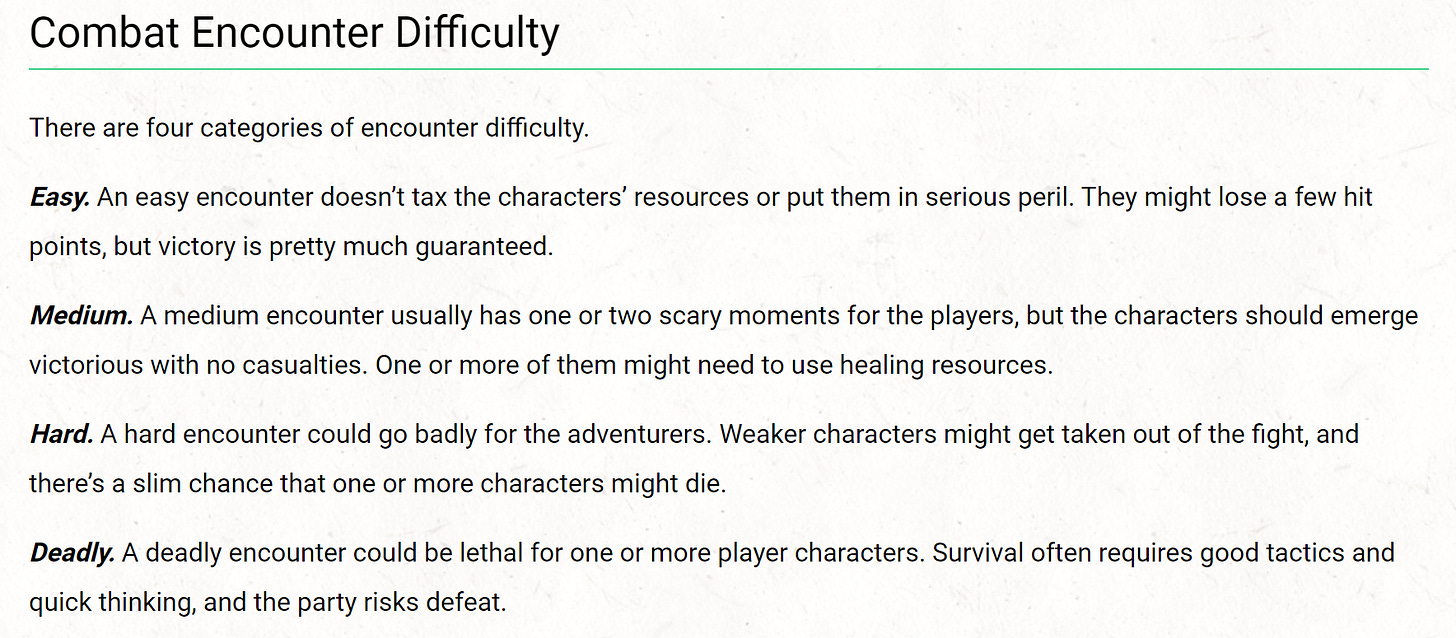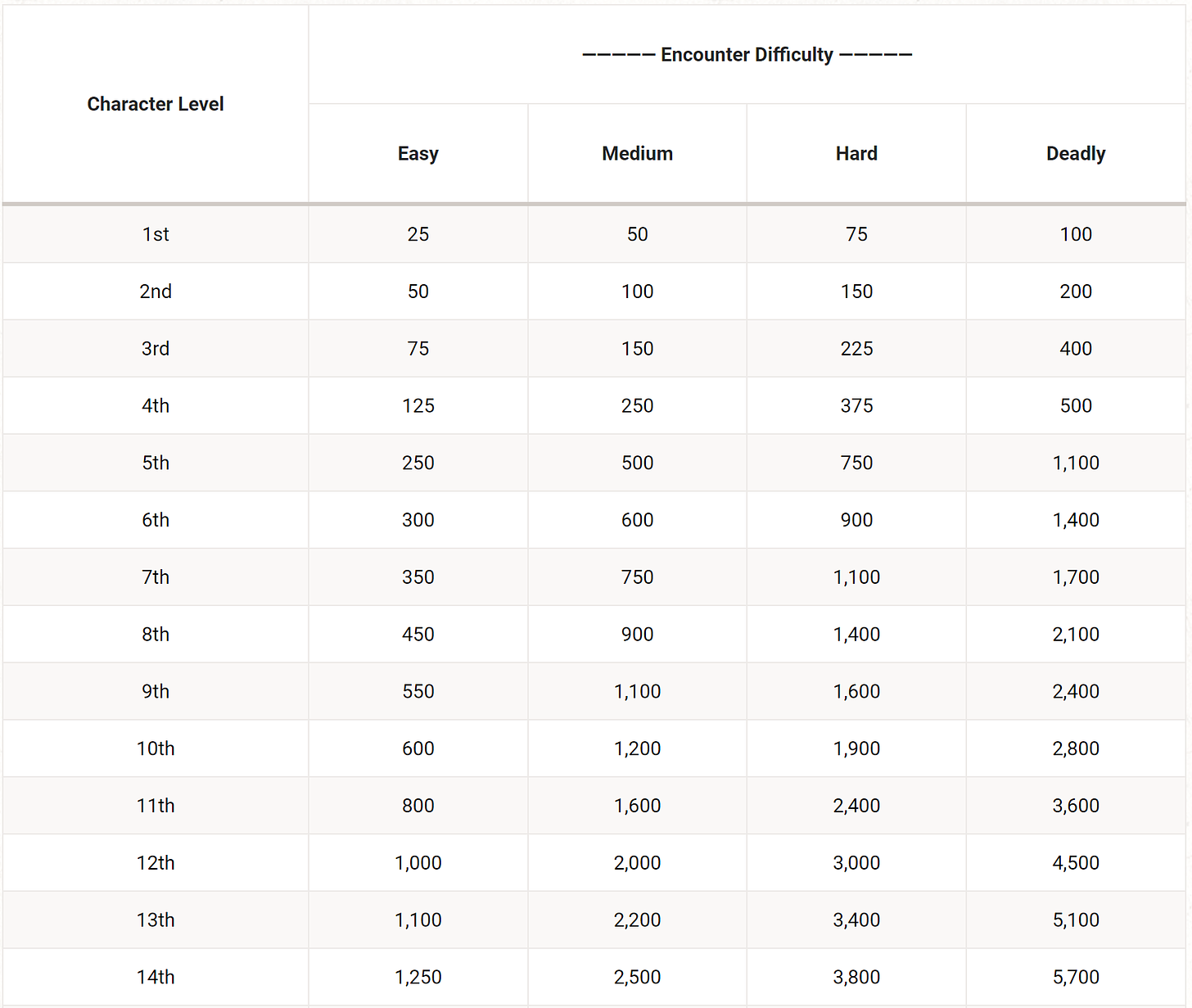It's common knowledge that the names of the 5e encounter difficulty ratings—Easy, Medium, Hard, and Deadly—are absolute nonsense and easily misunderstood.
Here's how I'd try to fix them.
The Basic Rules define a "Hard" encounter to mean that "weaker characters might get taken out of the fight, and there's a slim chance that one or more characters might die."
In practice, though, this definition is better-suited to the average "Deadly" encounter.
Why? Because the "Deadly" encounter difficulty is trying to do too much. It's trying to cover encounters where (a) there's a reasonable chance of death, (b) there's a high likelihood of death, and (c) death is certain.
The encounter difficulty names are doubly confusing because 5e is a game about resource management, not tactics or strategy. We need names that reflect the concept of "resource taxation," not names that reflect "player brainpower."
Here are my suggestions:
Rename the existing encounters using a taxation-based naming scheme.
Add two additional high-end encounter difficulties, and rebalance "Deadly" encounters accordingly.
An "Easy" encounter neither taxes the PCs' resources nor places them in serious peril. Let's call these "Light" encounters.
A "Medium" encounter may require the use of some serious resources, such as a high-level spell slot or hit dice. Let's call these "Moderate" encounters.
A "Hard" encounter is fairly challenging. If the PCs don't come out guns blazing—for example, by using short-rest abilities and multiple spell slots—they'll likely lose. Let's call these "Taxing" encounters.
We can split "Deadly" encounters into three categories:
A.) encounters that require a substantial dedication of resources
B.) encounters that require a substantial dedication of resources AND exceptional planning AND some luck, and
C.) encounters that are impossible to beat.
Let's call the encounters in Category A "Exhausting" encounters. These encounters will temporarily exhaust your resources and drive your PCs to their breaking point.
Next, let's call Category B encounters "Nightmare" encounters. Want to win? You'll need to play all of your cards right AND expend your arsenal.
Category C. This one is easy. "Impossible" encounters. The only winning move is not to play.
As for rebalancing—the Basic Rules' Encounter Difficulty Table generally increases the XP threshold by a constant amount from Easy to Medium to Hard, and then increases the XP threshold by 100-150% when moving from Hard to Deadly.
Our new tiers simplify this:
A Light encounter requires X experience points.
A Moderate encounter requires 2X experience points.
A Taxing encounter requires 3X experience points.
An Exhausting encounter requires 4X experience points.
A Nightmare encounter requires 6X experience points.
An Impossible encounter requires 8X experience points or more
Here’s the best part: You can use this new naming system without changing any of the underlying math.
If I want to create an Exhausting encounter for five 3rd-level characters, here's what I need to do:
Find the XP threshold for a 3rd-level Light encounter (75).
Multiply this XP threshold by four to get an Exhausting encounter (300).
Multiply this XP threshold by five players (1500).
This means that you can still use this approach with an encounter difficulty calculator like Kobold Fight Club, which automatically calculates the encounter's effective XP total—and an Easy encounter's XP threshold—for you.
For example, Curse of Strahd has an encounter with three CR 5 revenants—a legendarily deadly fight. Kobold Plus Fight Club says that's an adjusted XP total of 10,800.
For a party of five PCs, the XP threshold of an Easy/Light encounter (multiplied by five characters) is:
1500 at 6th level,
1750 at 7th level,
2250 at 8th level, and
2750 at 9th level.
That means that this encounter is:
☠ NIGHTMARE for the 6th-level PCs (7.2X) and 7th-level PCs (6.2X)
😬 EXHAUSTING for the 8th level PCs (4.8X), and
😰 TAXING for the 9th-level PCs (3.9X).
Seems about right to me!
Of course, this system doesn't fix combat difficulty completely. For example, it doesn’t resolve:
the intrinsic unreliability of the CR system in certain edge cases (such as shadows or intellect devourers)
the impact of environments or certain tactics
certain unbalanced subclasses (such as the Twilight Domain), or
the need to consider action economy (such as when making a boss fight).
Still, I hope this is a helpful way of looking at and reworking a system that's been long overdue for some rust-removal. Curious to know what y'all think!
Cover image credit to Wizards of the Coast.
DragnaCarta is a veteran DM, the author of the popular “Curse of Strahd: Reloaded” campaign guide, a guest writer for FlutesLoot.com, and the former Dungeon Master for the actual play series “Curse of Strahd: Twice Bitten.”
To support Dragna’s work and access perks like DMing workshops, homebrew content, personal campaign advice, and a supportive Discord community, you can click here to join his Patreon.
To get Dragna’s hot takes and commentary, you can click here to follow him on Twitter.







I think that the deeper concern throughout D&D's balance is that for the most part CR isn't a good estimate for the power level of a monster. Before being able to tackle encounters as a whole, I think that we need a better basis for what CR means, and how deadly a given monster of that CR is.
The waters are further muddied by the designers themselves having said that the monster manual was made keeping in mind that the PCs have no magic items, which... usually isn't the case in many games I've played with. All of these together make any sort of encounter balancing nigh impossible if we want to grab monsters from the monster manual and run a given encounter.